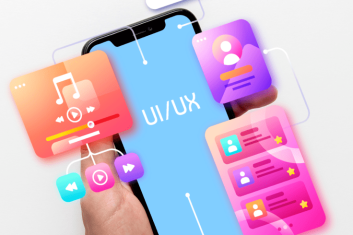Games are an essential part of our culture. Created as a fun way to pass some time, games have become more than that. They are now a big part of the entertainment industry, often designed to educate, provoke thought, express opinions and offer commentary.
Today, let’s take a look at how we can apply playful nuances to education to improve the learning experience, increase user engagement and retention, and gain a competitive edge.
Gamification can be implemented in almost all types of educational apps. Let’s talk about what it is and how it works.
What Is Gamification in E-Learning?
Gamification is a simple concept in education. The essence of it lies in incorporating some elements of a game — such as achievements, points, leaderboards, leveling — into the learning process to motivate and train.
The core of gamification:
The goal — to attract the attention of trainees, stimulate their interest in solving educational tasks, and help them understand how to use the acquired knowledge in practice.
The basic principle — constant feedback from users is used to tweak and adjust the learning process through gamification. Gamification provides phased immersion into the topic without losing the user’s attention.
The projection — gamification in the e-learning industry is predicted to be valued at almost $1.5 billion in 2020, 16 times that of 2015.
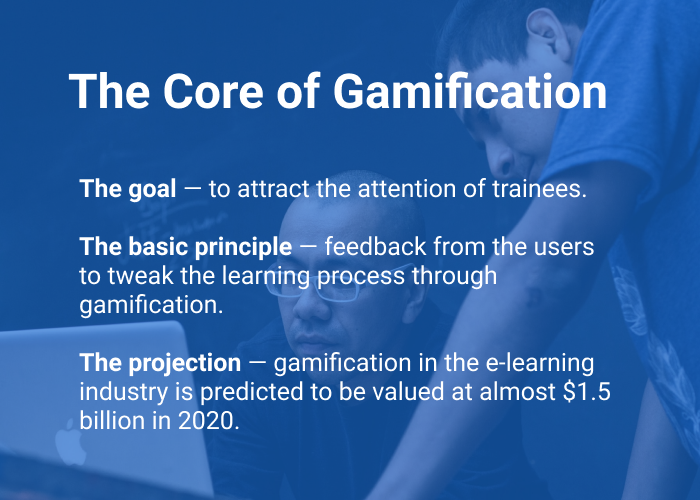
Core of gamification.
The most significant value of gamification is in leveraging users’ natural desire for socializing, learning, competition, achievement, status, self-expression, and closure.
What Are the Benefits of Gamification in E-Learning?
Benefits from the companies’ perspective
Engagement boost. Gamified elements such as leaderboards, rewards, progress bars, and points encourage competition and retention. Users feel encouraged to compete with each other and complete the courses trying their best.
Motivation and goal tracking. Gamification allows for setting specific, appealing targets that users work towards. Goal-tracking tools, progress points, and so on can fuel the feeling of accomplishment further.
Knowledge retention. Employees are more likely to remember the information they have acquired as a result of engaged effort.
Team building. Gamification techniques promote collaboration and knowledge sharing for the sake of achieving goals. Tasks and activities are designed in a way that allows users to benefit from cooperation.
Valuable feedback. Gamified LMS can be equipped with performance tracking tools that explain to users how they compete against one another, what they excel at, and what needs more work.
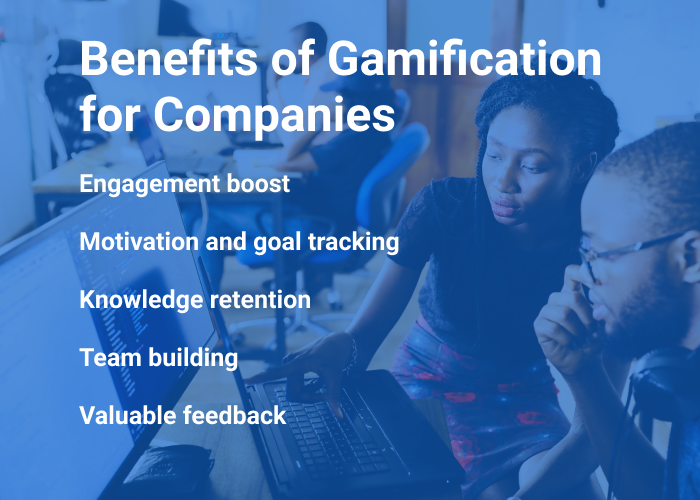
Benefits of gamification for companies.
Benefits from the trainees’ perspective
Productivity boost. Users claim that gamification is more productive in terms of teaching new skills.
Motivation. Trainees are more engaged in gamified learning activities, which keeps their interest high.
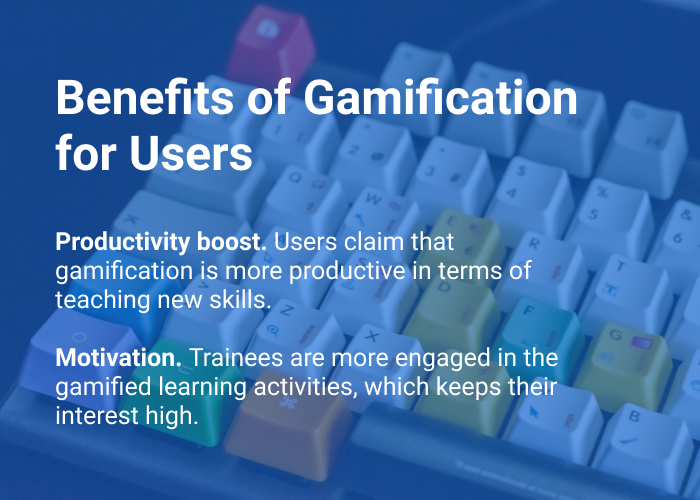
Benefits of gamification for users.
How Does Gamification in E-Learning Work?
Gamification is all about introducing gaming elements and wrapping them around the educational content. The most popular elements are:
Leaderboards. On e-learning platforms, leaderboards can be applied to a variety of activities, from quiz scores to the shortest time it took trainees to solve a puzzle. This way, trainees will be able to see how they are keeping up with others.
But keep in mind that competition can get out of hand and provoke toxic behavior. To avoid that, make sure leaderboards are not made permanent. Instead, go for weekly or monthly scores. This way, users who aren’t satisfied with their performance get a chance to score higher points next time.
Building leaderboards is not hard and takes a couple of lines of code if you want to integrate a pre-made third-party leaderboard component. Building your own solution from scratch will take a bit longer. The timeframe mainly depends on the scenario of the learning process: the team has to come up with the achievements that should be rewarded with points. Those points go into each user’s score and form a leaderboard.
So, the approximate timeframe of development is 16–80 hours.
Badges. Badges are a well-known staple of video games, which reward gamers who spend more time in the game. Users gain them for completing quests or breaking high scores.
In online education, badges can work well, too. They can serve as a reward for users who learn features of the platform, acquire new skills, or complete a certain number of courses.
To keep users interested in earning more badges, they must vary in difficulty: some should be pretty easy to get, while others must require more work. Trainees will breeze through the easy badges and will want more.
Badges also take a short time to build — around 40 hours. Before developing badges, developers have to determine what badges to build and what activities users should be rewarded for.
Points and currency. Apart from badges, users can be rewarded with points. And unlike badges, points can be used as currency. For instance, trainees can earn points for finishing the quiz faster or for asking additional questions, and then spend those points to get discounts on courses or purchase tips during classes.
One more great option for applying points is using them to guide the trainees through the platform. For instance, LMS can grant points to users for filling out their profiles, using the platform for several days in a row, and so on.
A team of e-learning software developers can create and implement a system of points in 40 hours. The points should be attached to certain activities, which the users complete in order to earn those points.
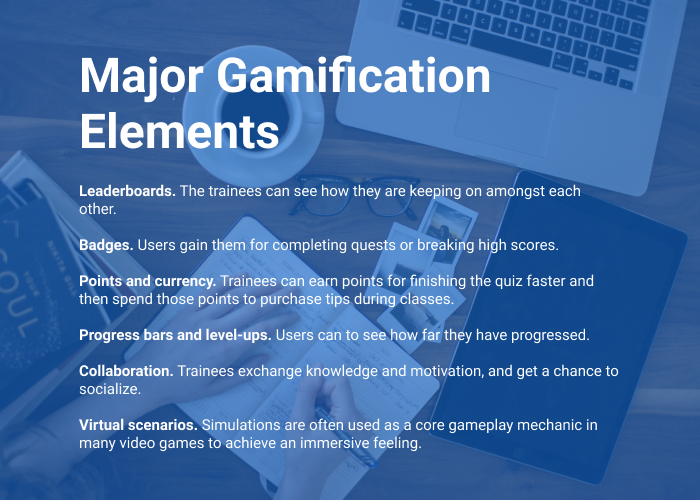
Major gamification elements.
Progress bars and level-ups. Most e-learning platforms do not have start and end dates, which can be demotivating. To keep users focused on their training goals, LMS can be powered by progress bars. Users will be able to see how far they have progressed.
Advanced visualization will help users keep themselves motivated. On top of that, level-ups can be added to grant users special course features.
Progress bars take from 16 to 40 hours to develop. A major part of the implementation is determining milestones that mark various levels users will surpass.
Collaboration. Gamification can be introduced in the form of activities that require teamwork. By working together, students exchange knowledge and motivation and get a chance to socialize.
Virtual scenarios. Simulations are often used as a core gameplay mechanic in many video games to achieve an immersive feeling.
Those solutions can be implemented in e-learning platforms to teach users how to navigate different situations better. Scenarios can also be useful for learning soft skills, customer services, and team-building activities.
Scenarios are wrapped around the whole learning process and include many elements, such as badges, points, progress bars, levels, and educational content, as well as audio and video content. Depending on the complexity of the scenario, the development process can take from 40 to 10 hours.
Below you can see the table that shows how much time and resources it takes to build a specific gamification element. The development column includes the number of hours for programmers to build a feature, while the total amount takes into account the efforts of the whole team with PM, UI/UX Designer, and QA Engineer.
| Feature | Dev min (h) | Dev max (h) | Total min (h) | Total max (h) | Rate ($) | Cost min ($) | Cost max ($) |
| Leader
boards |
16 h | 80 h | 25,6 h | 128 h | $35 | $896 | $4480 |
| Badges | 40 h | 40 h | 64 h | 64 h | $35 | $2240 | $2240 |
| Points and Currency | 40 h | 40 h | 64 h | 64 h | $35 | $2240 | $2240 |
| Progress bars | 16 h | 40 h | 25,6 h | 64 h | $35 | $896 | $2240 |
| Virtual scenarios | 40 h | 160 h | 64 h | 256 h | $35 | $2240 | $8960 |
Levels of Gamification
E-learning software developers can implement various gamification techniques to achieve different goals. Game mechanics can have different depths of implementation.
Level 1: Partial gamification
This is the entry-level stage of gamification. Users usually can see partial gamification in traditional learning activities, such as gamified quizzes and assessments.
Here’s how partially gamified e-learning works:
- The learner navigates through a series of challenges;
- Answers questions and solves puzzles to move ahead;
- Gets bonuses and points.
Level 2: Game-based learning
This way, the learning process is wrapped into a game. Apart from gaming activities, the process also features scores, awards, leaderboards, and progress bars.
- The learner follows the scenario of the game;
- The gamified nature of the learning process instills a sense of achievement and challenge;
- Some activities are aimed at acquiring knowledge, while others are meant for learners to apply that knowledge.
Level 3: Gamified learning path
The learning path is usually a walkthrough of some sort. Trainees go through a path to learn the features of a website, learn a skill, or know how to act in a certain situation.
- The learner goes through a path, topics of which are divided into levels;
- The learner completes challenges, earns experience points and badges;
- Learners each have their own dashboard to follow their performance.
Level 4: Gamified learning portal
A learning portal can host many varied educational activities to cater to users’ needs. Apart from that, the portal offers:
- Personalization in the form of user-profiles and avatars;
- Customization of learning paths;
- Collaboration in the form of social learning;
- Gamification in the form of points, badges, leaderboards, progress bars, and analytics.
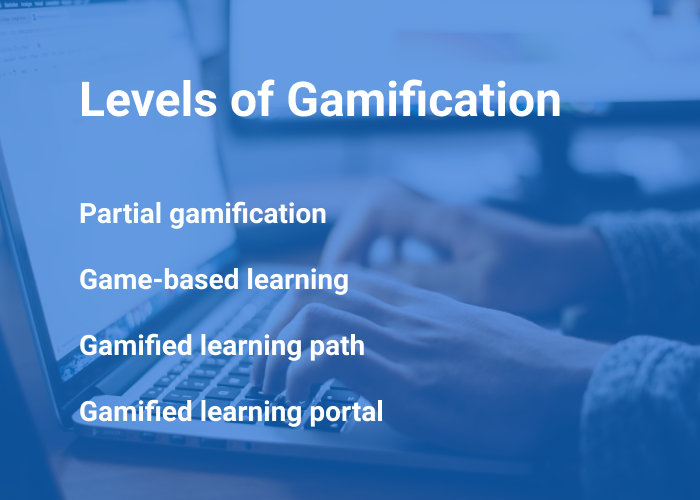
Levels of gamification.
Potential Mistakes in Gamified E-Learning
As with any other technique, poorly applied gamification can disrupt the educational process. To avoid that, stay focused on your goals when implementing game elements so the features you build make sense.
Here are the most common mistakes:
Meaningless awards. When used correctly, awards can keep motivation high and lead trainees through hard tasks. It makes sense to start off easily, giving awards for the simplest tasks. But if getting the next award does not get more difficult than the previous one, motivation may decline. Users must gain awards for indisputable and objective achievements.
Short strategy. Think about the big picture. Despite how innovative and engaging your mechanic is, eventually it will get boring. Make sure trainees are always challenged with engaging and varied tasks.
Focus on the competition. Competition is the driving factor in learning through game mechanics. But there is a chance that competition can turn into rivalry if not controlled. Competition can be balanced out with activities requiring teamwork and cooperation. Keep your users focused on the main goal of the task and not on leaderboards.
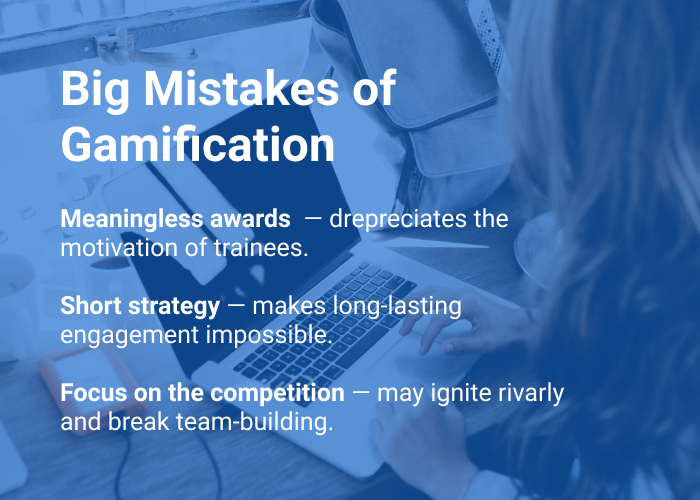
Mistakes of gamification.
Examples of Gamification in E-Learning
Duolingo
Duolingo is a language learning platform. Training is based on short lessons which include many game elements.
Lessons are divided into levels. Users can gain access to the next level after completing the previous one. Students earn points for completing tasks: the fewer mistakes they make, the more points they get.
Also, there is a local currency available for users, which they can use to purchase optional modules and tests. Students can join collective projects, such as translations of large text.
The progress is documented and presented to the users in the form of leaderboards. There are different leaderboards for each language.
Stav Online
Stav online is an e-learning solution that focuses on teaching the Danish language. The software is actually an adaptation of a successful series of books on Danish spelling and grammar.
Gaming elements in the learning process are in place to induce healthy competition and engage students. Stav online organizes lessons into roadmaps where users unlock lessons by completing tasks and earning points. Points can be spent on tips. Also, there are progress bars for both students and teachers.
Want to apply Gamification to your E-learning solution?
We are glad to offer our help – at HQSoftware, we provide highly skilled developers to tackle your project.
Anna Halias
Business Development Manager,
HQSoftware
Coursera
Coursera is an educational marketplace that hosts courses in many fields, from software development to gardening. The courses are provided by independent instructors, who sell them separately.
There is not much going on in terms of gamification in Coursera, but they do use some of these techniques to keep the learning process interesting.
For instance, students use progress bars to track how they perform during classes. Also, trainees can constantly monitor their progress with constant feedback from instructors with provided tools. Classes are also divided into levels.
UberDrive Game
UberDrive Game is a free mobile application that helps Uber drives memorize the most efficient routes in their city and improve navigation skills.
Drivers can build routes as they please when picking up and dropping off virtual passengers. They get more points for using the safest and most efficient routes. This way the drivers can improve their navigation skills and study the city.
Lifesaver
Lifesaver is a story-led life-saving game meant to teach users CPR. It is an interactive guide in the form of a mobile application available for iOS and Android.
To provide an immersive experience, the application leads users through three scenarios set within time limits. Following the instructions, the user performs CPR. His or her performance is scored at the end of each scenario.
Bottom Line
Gamification is one of the best tools to increase the effectiveness of online learning. Various applications of gamification can be deployed to solve various problems of education on the web.
Gamification can help boost e-learning for both trainees and companies providing online education. While learners will get a more immersive and motivating experience, companies will be sure that their staff learns important skills in the most effective way.
E-learning software developers can implement gaming mechanics differently. Applications vary, from partially gamified quizzes with bonuses to full-fledged virtual scenarios with progress bars and leaderboards.

Founder
Hey! Welcome to our blog!
The topics we cover include IoT, AR/VR, related news, and our projects.If you’d
like to discuss an article, please
messsage
me on LinkedIn
Related Posts
View All
We are open to seeing your business needs and determining the best solution. Complete this form, and receive a free personalized proposal from your dedicated manager.

Sergei Vardomatski
Founder


